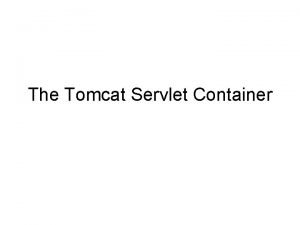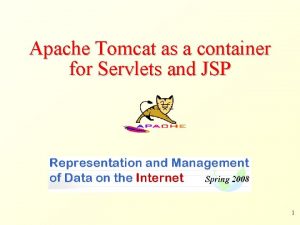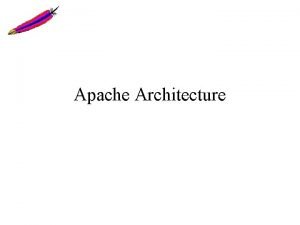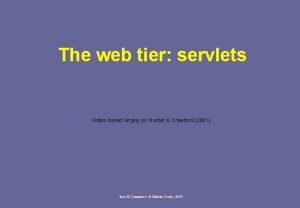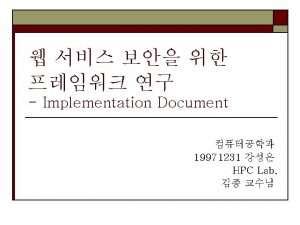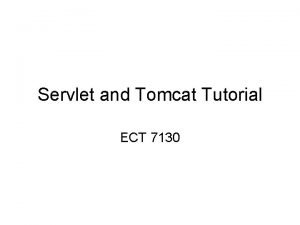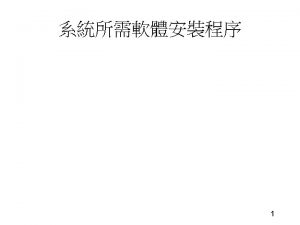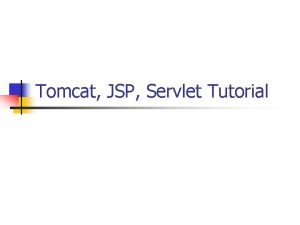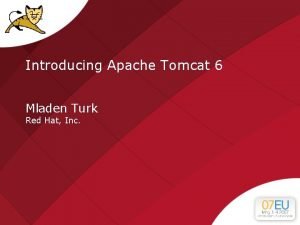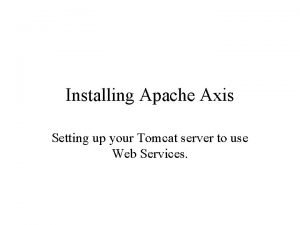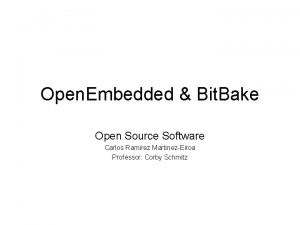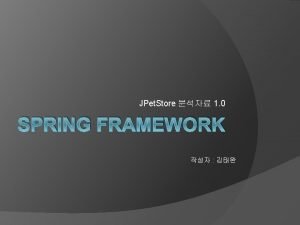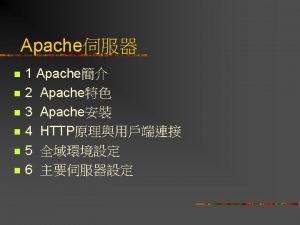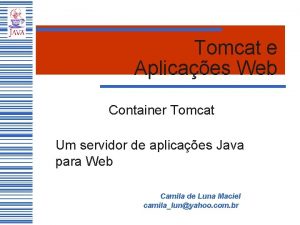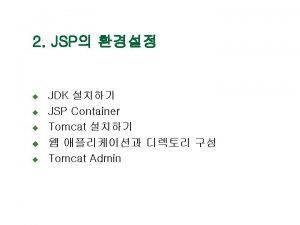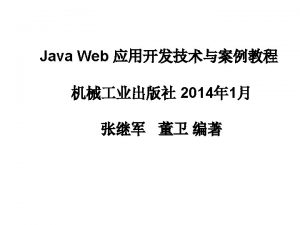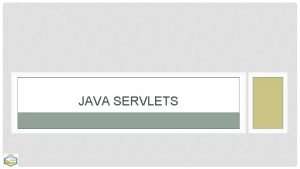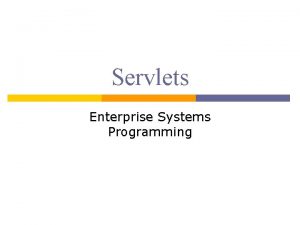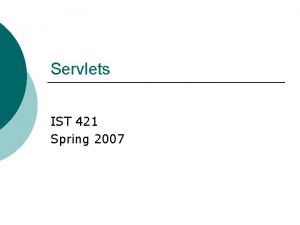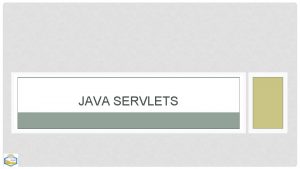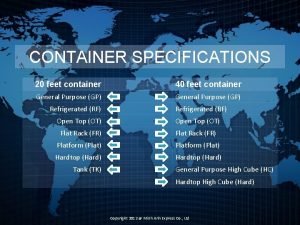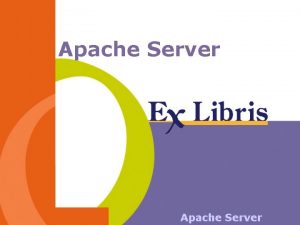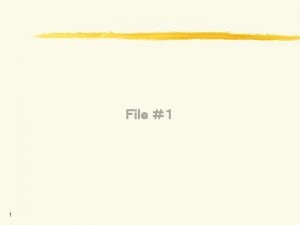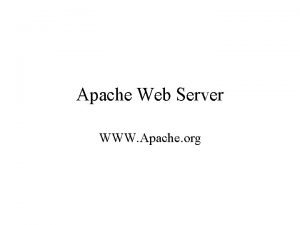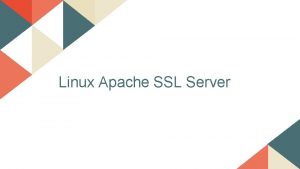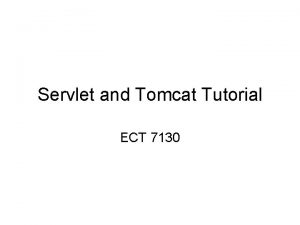Apache Tomcat as a container for Servlets and














































- Slides: 46

Apache Tomcat as a container for Servlets and JSP 1

What is Tomcat? • Tomcat is a Servlet container (Web server that interacts with Servlets) developed under the Jakarta Project of Apache Software Foundation • Tomcat implements the Servlet and the Java Server Pages (JSP) specifications of Sun Microsystems • Tomcat is an open-source, non commercial project - Licensed under the Apache Software License • Tomcat is written in Java (OS independent) 2

Reminder: A Servlet Example public class Hello. World extends Http. Servlet { public void do. Get(Http. Servlet. Request request, Http. Servlet. Response response) throws Servlet. Exception, IOException { Print. Writer out = response. get. Writer(); out. println("<html><head><title>Hello</title></head>"); out. println("<body>"); out. println("<h 2>" + new java. util. Date() + "</h 2>"); out. println("<h 1>Hello World</h 1></body></html>"); } } Hello. World. java http: //localhost/dbi/hello 3

Reminder: A JSP Example <html> <head> <title>Hello World</title> </head> <body> <h 2><%= new java. util. Date() %></h 2> <h 1>Hello World</h 1> </body> </html> hello. jsp http: //localhost/dbi/hello. jsp Pay attention to the fact a cookie is placed in the client… We’ll discuss it next lessons 4

Reminder: Another JSP Example <html> <head><title>Numbers</title></head> <body> <h 1>The numbers 1 to 10: </h 1> <ul> <% int i; for (i=1; i<=10; ++i) { %> <li>Number <%=i%> </li> <%}%> </ul> </body> numbers-xhtml. jsp </html> http: //localhost/dbi/numbers-xhtml. jsp 5

Running Tomcat 6

Tomcat Directory Structure Tomcat-Base conf logs webapps server. xml ROOT my. App 1 my. App 2 work shared lib classes WEB-INF web. xml lib classes Tomcat-Home bin common lib classes 7

Base and Home Directories • The directory TOMCAT-HOME contains executables and libraries required for the server launching, running and stopping - This directory is placed under /usr/local/… • The directory TOMCAT-BASE contains the Web-site content, Web applications and configuration data - This directory is placed under your home directory 8

Installing Tomcat in the CSE Net • Create a directory for tomcat base - For example: mkdir ~/tomcat-base • Set the environment variable CATALINA_BASE to your tomcat-base directory - For example: setenv CATALINA_BASE ~/tomcat-base - Insert this line into your. cshrc file • Run ~dbi/tomcat/bin/setup • $CATALINA_BASE is now a regular Tomcat base directory, and Tomcat is ready to run 9

Running Tomcat in the CSE Net • To start tomcat use ~dbi/tomcat/bin/catalina run • Or, in background, ~dbi/tomcat/bin/catalina start • To stop tomcat use ~dbi/tomcat/bin/catalina stop Don’t forget to stop the server before you logout… • To see the default page of Tomcat from your browser use the URL http: //<machine-name>: <port>/ - machine-name is the name of the machine on which Tomcat runs and port is the port you chose for Tomcat • You can also use http: //localhost: <port>/ if your browser runs on the same machine as Tomcat Open http: //localhost: <port> In class port number is 80, you can check /conf/server. xml 10

From Scratch to Server in the CSE Net 11

12

Choosing a port for Tomcat • In the file $CATALINA_BASE/conf/server. xml you will find the element Connector of Service “Catalina” • Choose a port (greater than 1024 – why? ) and change the value of the port attribute to your chosen one: <Server> … <Service name="Catalina”> <Connector port="8090"/> … </Service> … </Server> 13

Creating Web Applications 14

Creating Web Applications • A Web application is a self-contained subtree of the Web site • A Web application usually contains several different types of Web resources like HTML files, Servlets, JSP files, and other resources like Database tables • Each Web application has its own subdirectory under the directory $CATALINA_BASE/webapps/ 15

The Directory Structure of a Web Application • Tomcat automatically identifies a directory $CATALINA_BASE/webapps/my. App/ with the relative URL /my. App/ • For example, a file named index. html in my. App is mapped to by the following URLs: http: //machine: port/my. App/index. html http: //machine: port/my. App/ 16

The Directory Structure of a Web Application • You can also use subdirectories under my. App • For example: the file my. App/my. Images/im. gif is mapped to by the URL http: //machine: port/my. App/my. Images/im. gif • By default, Tomcat maps the root directory (http: //localhost: 8090/) to the directory webapps/ROOT/ - You can change this default 17

The Directory Structure of a Web Application • An application's directory must contain the following: - The directory WEB-INF/ - A legal web. xml file under WEB-INF/ Minimal content of web. xml <web-app> </web-app> 18

From Scratch to Applications 19

Check an example where there are files in the given directory URL : http: //localhost/dbi/code/ 20

Configuring a Web Application • Application-specific configuration and declarations are written in the file my. App/WEB-INF/web. xml • This file contains: - Servlet declarations, mappings and parameters - Default files for directory requests (e. g index. html) - Error pages (sent in cases of HTTP errors) - Security constraints - Session time-out specification - Context (application) parameters - And more… 21

Error Pages • Use the error-page element to define the page sent in case of an HTTP error that occurs within the application context • An error page element has two sub elements: - error-code - the HTTP error status code - location - the page that should be sent 22

Error Page Example <html> my 404. html <head><title>Not Found</title></head> <body> <h 1 style="text-align: center; color: green"> Sorry, no such file. . . </h 1> </body> <web-app> web. xml </html> <error-page> <error-code>404</error-code> <location>/my 404. html</location> </error-page> </web-app> 23

A non-existing resource The problem with this example is that the browser caches this response as the resource of the requested URL and next time you refer to this URL will lead to SC=200 instead 404 (see why in the next slide). You can solve this problem simply by changing the errorpage file suffix from , html to. jsp (how does this solve the problem? ) You should also change the content of the web. xml to reflect the renaming 24

25

Welcome Pages • The (optional) welcome-file-list element contains a list of file names • When the URL request is a directory name, Tomcat automatically brings the first file on the list • If that file is not found, the server then tries the next file in the list, and so on • This file can be of any type, e. g. , HTML, JSP, image, etc. • The default welcome list for all applications is set in $CATALINA_BASE/conf/web. xml 26

Welcome Page Example <html> welcome. html <head><title>Welcome</title></head> <body> <h 1 style="text-align: center; color: red"> Welcome Dear Visitor! </h 1> </body> <web-app> web. xml </html> <welcome-file-list> <welcome-file>welcome. html</welcome-file> <welcome-file>index. jsp</welcome-file> </welcome-file-list> </web-app> 27

28

Tomcat and Java Classes • Tomcat uses Java classes you provide in order to run Servlets and JSP files - For example, the Servlets themselves! • Tomcat 5. x initialization scripts ignore your environment CLASSPATH variable • Classes are expected to be placed (or linked) at some predefined places in its directories • There actually 5 or 6 more and less restrictive classpaths used by tomcat – can you think why? • Hint: how would a malicious web application gain control of another, innocent, web application? 29

Java Class Locations • Tomcat expects to find Java classes in class files (in a directory named classes) and JAR files (in a directory named lib) in the following places: • TOMCAT-HOME/common/ - Basic runtime classes. No need to touch this directory • $CATALINA_BASE/webapps/my. App/WEB-INF/ - Application-specific classes (Servlets are typically here) • $CATALINA_BASE/shared/ - Classes that are used by all the Web applications 30

Java Class Locations 31

Classes Provided by DBI In order to provide the classes you need, like ORACLE, SAX and DOM-related packages, the Tomcat-setup script links the directory $CATALINA_BASE/shared/lib/ to ~dbi/tomcat/shared/lib/, thus the latter packages are automatically known by your Tomcat server 32

Publishing a Servlet • We know how file resources (e. g HTML, JSP, images) are published using Tomcat • In order to publish a Servlet in Tomcat, we have to do the following: - Put the class file in a proper place - Tell Tomcat the class acts as a Servlet - Tell Tomcat the URL mapping of the Servlet • The last two are discussed in the following slide 33

Servlet Declaration and Mapping • The element <servlet> declares a Servlet • The sub element <init-param> defines an We’ll mention it parameter passed to the Servlet again later - Access using Servlet. Config. get. Init. Parameter() • The element <servlet-mapping> maps a URL to a specific Servlet - The URL is relative to the application’s base URL (http: //machine: port/my. App/) 34

Publishing a Servlet -An Example <web-app> web. xml <servlet> <servlet-name>hello</servlet-name> <servlet-class>Hello. World</servlet-class> </servlet> my. App/WEB-INF/classes/Hello. World. class <servlet-mapping> <servlet-name>hello</servlet-name> <url-pattern>/hi</url-pattern> The 2 blocks do not have to be adjacent </servlet-mapping> within web. xml </web-app> http: //localhost/my. App/hi 35

A Tip • Tomcat provides a Servlet that enables invoking an existing Servlets without declarations and mappings • To enable this feature, uncomment the elements servlet and servlet-mapping of the Servlet called invoker in $CATALINA_BASE/conf/web. xml • To call the compiled Servlet my. Servlet. class in the application my. App use this URL: http: //<machine>: <port>/my. App/servlet/my. Servlet • NEVER publish a Web-site with this feature enabled! - Otherwise, your security restrictions are easily bypassed (try to think how this can be achieved) 36

web. xml DTD Your web. xml file must conform to the web-app DTD: <!ELEMENT web-app (icon? , display-name? , description? , distributable? , context-param*, filter-mapping*, listener*, servlet-mapping*, session-config? , mime-mapping*, welcome-file-list? , error-page*, taglib*, resource-env-ref*, resource-ref*, security-constraint*, login-config? , security-role*, enventry*, ejb-ref*, ejb-local-ref*)> 37

Our Entire web. xml so far <web-app> web. xml <servlet> <servlet-name>hello</servlet-name> <servlet-class>Hello. World</servlet-class> </servlet> <servlet-mapping> <servlet-name>hello</servlet-name> <url-pattern>/hi</url-pattern> </servlet-mapping> 38

Our Entire web. xml so far <welcome-file-list> web. xml <welcome-file>welcome. html</welcome-file> <welcome-file>index. jsp</welcome-file> </welcome-file-list> <error-page> <error-code>404</error-code> <location>/my 404. html</location> </error-page> </web-app> 39

Web Application Development 40

Web Archives • A WAR (Web ARchive) file is a JAR file that contains a whole Web-application directory • For example, to create a WAR file of my. App do: cd webapps/my. App jar cvf my. App. war * (don’t forget the filename! What would happen otherwise? ) • Tomcat unpacks all WAR files found in $CATALINE_BASE/webapps/ at statup - The unpacked directory and context will be named as the WAR file name (without the. war extension) - The WAR will not be unpacked if webapps/ already contains the directory and the WAR is not newer. . . - Why not keep the applications packed? - If we must unpack them, why pack them to begin with? 41

Reflecting Application Changes • Changes in your Java classes may not be reflected in your application - Old versions may already have been loaded - The application needs to be reloaded • Changes in other files like HTML or JSP are always reflected • Modification of web. xml automatically causes the application to be reloaded 42

Tomcat 5. 5 Manager • Tomcat 5. 5 comes with a Web application called “manager”, which supports functions for managing Web applications • You can either use the HTML interface at http: //<machine>: <port>/manager/html/ or send direct HTTP requests to it • You will need to authenticate as a privileged user - Use the username “admin” with no password 43

Tomcat 5. 5 Manager • Using the manager, you can - Deploy a Web application by posting a WAR file - Undeploy a deployed Web application - Start/stop a Web application (make it available/unavailable) - Reload an existing Web application (unpack new WARs) • Warning: while “stop” makes an application unavailable, “undeploy” deletes the application directory and WAR file from webapps/ Find these options in the tomcat manager GUI 44

Tomcat and Eclipse • You can use an Eclipse plugin for Tomcat Webapplication development • The “Sysdeo Eclipse Tomcat Launcher” plugin is installed in CS • Using this plugin, you can start/stop the server, reload an application, etc. • Detailed explanations in the course technical-help section 45

46
 Apache tomcat servlet container
Apache tomcat servlet container Apache tomcat container
Apache tomcat container Apache tomcat digitalization
Apache tomcat digitalization Architecture as measure
Architecture as measure Tomcat production configuration
Tomcat production configuration Waste management plan sample philippines
Waste management plan sample philippines Coreservlets
Coreservlets Servlets notes
Servlets notes Tomcat soap
Tomcat soap Tomcat tutorial
Tomcat tutorial Tomcat ee
Tomcat ee Tomcat servlet tutorial
Tomcat servlet tutorial Pfister tomcat
Pfister tomcat Mladen turk
Mladen turk Axis tomcat
Axis tomcat Intellij tomcat
Intellij tomcat Tomcat-connectors
Tomcat-connectors Embedded tomcat
Embedded tomcat Jpetstore
Jpetstore Tomcat
Tomcat Tomcat настройка
Tomcat настройка Passenger management system
Passenger management system Fspos
Fspos Typiska drag för en novell
Typiska drag för en novell Nationell inriktning för artificiell intelligens
Nationell inriktning för artificiell intelligens Ekologiskt fotavtryck
Ekologiskt fotavtryck Varför kallas perioden 1918-1939 för mellankrigstiden
Varför kallas perioden 1918-1939 för mellankrigstiden En lathund för arbete med kontinuitetshantering
En lathund för arbete med kontinuitetshantering Underlag för särskild löneskatt på pensionskostnader
Underlag för särskild löneskatt på pensionskostnader Personlig tidbok för yrkesförare
Personlig tidbok för yrkesförare Anatomi organ reproduksi
Anatomi organ reproduksi Förklara densitet för barn
Förklara densitet för barn Datorkunskap för nybörjare
Datorkunskap för nybörjare Tack för att ni lyssnade bild
Tack för att ni lyssnade bild Debattartikel struktur
Debattartikel struktur Delegerande ledarstil
Delegerande ledarstil Nyckelkompetenser för livslångt lärande
Nyckelkompetenser för livslångt lärande Påbyggnader för flakfordon
Påbyggnader för flakfordon Formel för lufttryck
Formel för lufttryck Publik sektor
Publik sektor Kyssande vind analys
Kyssande vind analys Presentera för publik crossboss
Presentera för publik crossboss Vad är ett minoritetsspråk
Vad är ett minoritetsspråk Plats för toran ark
Plats för toran ark Treserva lathund
Treserva lathund Epiteltyper
Epiteltyper Bästa kameran för astrofoto
Bästa kameran för astrofoto
